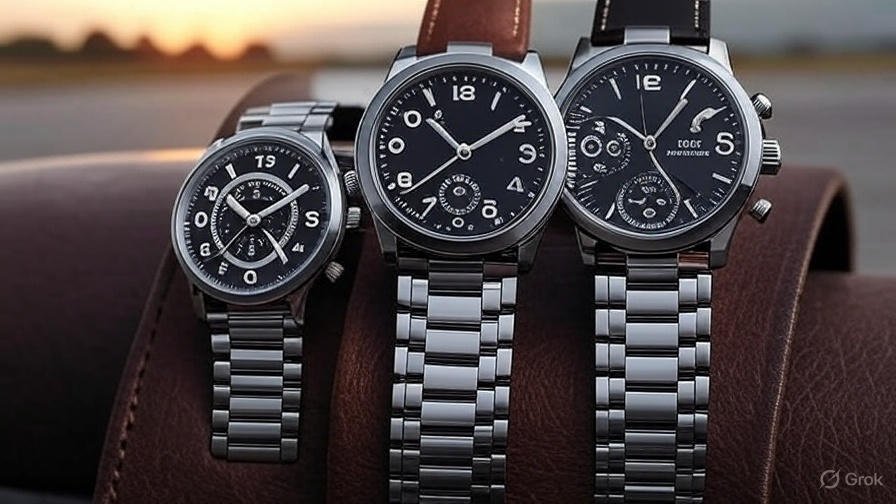In the world of luxury timepieces, IWC Schaffhausen’s Pilot Watches have long been celebrated for their precision, durability, and timeless design. Known for their aviation-inspired aesthetic, these watches have captured the attention of watch enthusiasts and professionals alike. However, their premium price tags often place them out of reach for many. Enter the growing market for replica IWC Pilot Watches, which has surged in popularity due to their blend of style, craftsmanship, and affordability. This trend has sparked discussions among collectors, fashion enthusiasts, and industry experts about the implications of replicas in the luxury watch market.
The Appeal of IWC Pilot Watches
IWC Pilot Watches, first introduced in the 1930s, were designed for aviators who needed reliable, legible timepieces under challenging conditions. Their iconic features—large dials, luminous hands, and robust movements—made them a favorite among pilots and later, watch collectors. Models like the IWC Big Pilot and the Mark series have become synonymous with sophistication and functionality, blending rugged utility with refined elegance.
The allure of these watches lies in their heritage and meticulous craftsmanship. Each piece is a testament to IWC’s commitment to quality, often featuring intricate details like anti-magnetic properties and high-end materials. However, with prices for authentic IWC Pilot Watches ranging from several thousand to tens of thousands of dollars, they remain a distant dream for many watch enthusiasts.
The Rise of Replicas
In recent years, replica watches have carved out a significant niche in the market, offering consumers an affordable alternative to luxury brands. Replica IWC Pilot Watches, in particular, have gained traction for their ability to mimic the look and feel of the originals at a fraction of the cost. These replicas range from low-quality imitations to high-grade reproductions that closely resemble their authentic counterparts in design and functionality. For those interested in other luxury replicas, such as rolex replica watches, the market offers similar options for accessible luxury.
The demand for replicas has been fueled by a growing interest in horology among younger demographics, particularly millennials and Gen Z, who value style but may lack the budget for high-end watches. Social media platforms have played a significant role in this trend, with influencers showcasing affordable alternatives that allow consumers to emulate the luxury lifestyle without breaking the bank. Posts on X have highlighted the rising popularity of these replicas, with users praising their aesthetic appeal and accessibility.
Craftsmanship and Quality
Not all replicas are created equal. High-quality replicas, often referred to as “super clones,” are crafted with remarkable attention to detail. These watches may use materials like stainless steel, sapphire crystal, and reliable automatic movements to closely replicate the originals. Some manufacturers even go as far as studying the weight, texture, and engravings of authentic IWC Pilot Watches to ensure a near-identical experience.
While these high-end replicas are still significantly cheaper than authentic IWC watches, they often cost several hundred dollars, reflecting the effort put into their production. Lower-end replicas, on the other hand, may cut corners with cheaper materials and less accurate movements, resulting in a product that looks the part but lacks durability or precision. For consumers, the choice between high- and low-quality replicas often comes down to budget and priorities—whether they prioritize aesthetics over longevity or vice versa.
The Ethical Debate
The rise of replica watches has not been without controversy. Critics argue that replicas undermine the luxury watch industry by diluting brand value and potentially supporting unethical manufacturing practices. Authentic IWC watches are the result of years of expertise, innovation, and rigorous quality control, and replicas can be seen as profiting off this legacy without contributing to it. Additionally, some replica markets have been linked to counterfeit operations, raising concerns about intellectual property theft and unregulated labor conditions.
Proponents of replicas, however, see them as a democratizing force in the world of luxury goods. For many, owning a replica IWC Pilot Watch is not about deceiving others but about enjoying the design and craftsmanship of a high-end watch at a more accessible price point. Some argue that replicas can even serve as a gateway to the world of horology, sparking interest in authentic luxury watches as consumers’ budgets grow. For more insights into the replica market, resources like Watchuseek offer discussions on both replicas and authentic timepieces.
Market Dynamics and Consumer Trends
The market for replica IWC Pilot Watches has grown alongside broader trends in consumer behavior. The rise of e-commerce and global marketplaces has made it easier than ever for consumers to access replicas from manufacturers worldwide. Online forums, review sites, and social media platforms have become hubs for discussions about the best replica makers, with enthusiasts sharing tips on spotting high-quality pieces and avoiding scams.
Interestingly, the popularity of replicas has not necessarily harmed the luxury watch market. Some industry analysts suggest that replicas cater to a different audience—one that may not have purchased an authentic IWC watch in the first place. Meanwhile, luxury brands continue to thrive, with IWC reporting strong sales in recent years, driven by demand for limited-edition models and collaborations.
Posts on X reflect this nuanced dynamic, with some users expressing admiration for the craftsmanship of replicas while others remain staunch supporters of authentic watches. The conversation underscores a broader shift in how consumers perceive value, with affordability and accessibility becoming key considerations in the luxury goods market.
The Future of Replica Watches
As technology advances, the quality of replica watches is likely to improve, further blurring the line between authentic and imitation timepieces. Innovations in manufacturing, such as 3D printing and advanced material science, could enable replica makers to produce even more convincing products. This raises questions about how luxury brands like IWC will adapt to a market where high-quality replicas are increasingly accessible.
For consumers, the decision to purchase a replica IWC Pilot Watch often comes down to personal values and financial considerations. While some may see replicas as a practical way to enjoy luxury aesthetics, others remain committed to the heritage and exclusivity of authentic watches. Regardless of where one stands, the rise of replicas has undeniably reshaped the watch industry, sparking conversations about accessibility, craftsmanship, and the evolving definition of luxury.
Conclusion
The surge in popularity of replica IWC Pilot Watches reflects a broader cultural shift toward affordability and inclusivity in the luxury goods market. By offering a stylish and accessible alternative to high-end timepieces, replicas have captured the imagination of a new generation of watch enthusiasts. While the ethical and legal implications of replicas remain a point of contention, their impact on consumer behavior and market dynamics is undeniable. As the watch industry continues to evolve, the balance between authenticity and affordability will likely remain a central theme in discussions about luxury timepieces.
Whether one chooses an authentic IWC Pilot Watch or a well-crafted replica, the enduring appeal of these aviation-inspired designs is a testament to their timeless style and functionality. As the market for replicas grows, it will be fascinating to see how brands and consumers navigate this new era of horology.
More information please visit BOUNDHUB.




